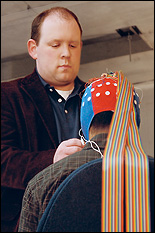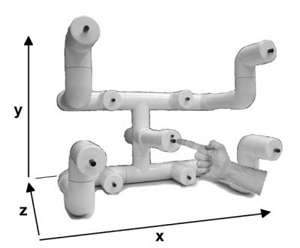News Story
Reconstructing Hand Movements Using Brain Signals

Bioengineering graduate student Trent Bradberry prepares a volunteer to use the EEG sensor cap that relays signals generated by the brain.
"Until now," says Contreras-Vidal, "this was not thought possible—people assumed EEG data was too limited."
The findings are significant because they open the door to the development of safe, portable, brain-controlled assistive devices for the neurologically-impaired or physically disabled. Prior to this study, researchers have used non-invasive but non-portable magnetoencephalography (MEG) technology and invasive methods that implanted sensors in the brain to reconstruct hand motions.
 | |
The reaching apparatus used to study the finger paths from a center button to eight other buttons in random order. While volunteers touched the buttons, researchers recorded their brain signals and hand motions. Afterward, the researchers attempted to decode the signals and reconstruct the 3-D hand movements. (Image courtesy of the Journal of Neuroscience.) |
"Our results showed that electrical brain activity acquired from the scalp surface carries enough information to reconstruct continuous, unconstrained hand movements," says Contreras-Vidal. "We are currently working with [controlling] robotic arms and wearable upper limb exoskeletons, but our findings could also lead to improvements in existing EEG-based systems that are designed to allow people to control a computer cursor with their thoughts."
The information gathered by the ongoing study, he adds, could also help doctors understand how the progression of neurological disorders such as Parkinson's disease affect the brain's ability to control the body's movements.
Bradberry's groundbreaking research has recently been covered by Scientific American, NPR’s Science Friday, and TV Globo News (Brazil; in Portuguese).
The research was supported by the Paris-based La Fondation Motrice.
Story adapted from the original University of Maryland press release, courtesy of Leon Tune.
For More Information:
Learn more about Trent Bradberry and his work »
Watch a demonstration at the School of Public Health's Healthy Turtle blog »
Published March 30, 2010









